Aion Review: The Interoperable dApp Development Platform
Aion is a project with pretty ambitious goals. They want to be a common protocol that will connect a whole host of other blockchains.
Aion was launched back in the hysteria of the 2017 bull run and was able to complete a pretty sizable ICO in the same year. Since then, they have been slowly building out their tech and progressing on their roadmap.
However, does Aion still have potential?
In this Aion review, I will give you everything that you need to know about the project. I will also analyse the use cases and long term adoption potential the Aion tokens.
What is Aion?
Aion is considered a 3rd generation blockchain platform, and it is trying to add interoperability across all blockchains, both public and private. This is achieved through the use of a “token bridge” enabling tokens from each chain to move flawlessly across all chains.
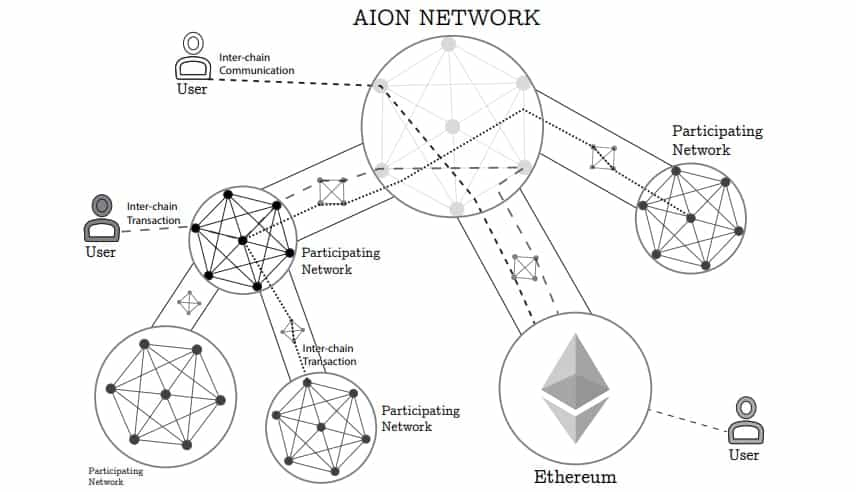
Basically, the vision is to create something similar to the internet, but for blockchains. Aion works as the network bridge that allows data and value to transfer seamlessly between Aion-compliant blockchains.
The platform was designed with high scalability, which leads to quick processing of transactions, as well as higher capacity for data transfer and the ability to customize public and private enterprise blockchains.
Aion Technical Overview
While at its core the Aion project is known to be about interoperability, the development team is also working behind the scenes to ensure that the root chain of Aion is leveraged.
That means that in addition to running cross-chain dApps, monetizing inter-chain bridges, and creating new blockchain platforms, the Aion token becomes the fuel to secure the entire network. The Aion platform has massive potential in its ability to execute smart contracts and to run dApps of all kinds.
The platform already has an abundance of tools that have been created for developers to create new dApps on the Aion chain. These tools have given developers the ability to deploy smart contracts as well as migrate existing Ethereum dApps to the Aion root chain.
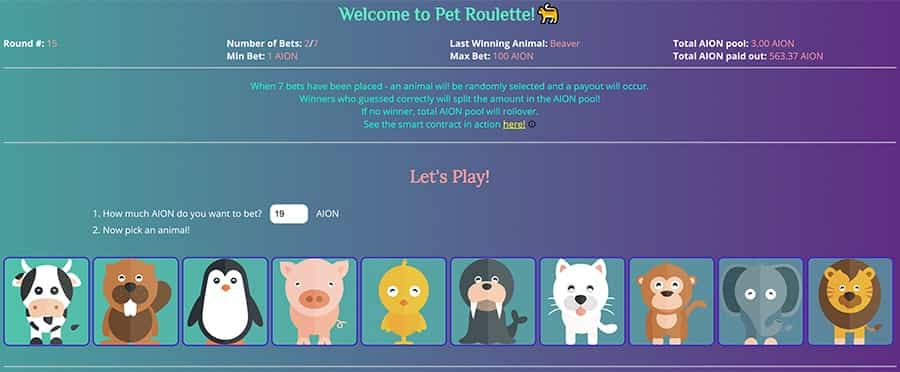
This migration can take place in just five minutes, making it not only simple, but also quick to port an Ethereum dApp to the Aion root chain.
The Aion FastVM, which has been released to the main network in early June 2019, is basically a modified version of the Ethereum Virtual Machine. The difference between the two is that the Aion FastVM is lightweight and performant, as well as leveraging certain attributes of the Java Virtual Machine.
This means Aion not only supports applications written in Solidity, but it also supports applications written in Java, which opens development to a huge pool of existing Java developers.
The Aion Network
Aion was created as a multi-tier network, which is familiar to most because that’s the same way a basic computer network is constructed. Aion passes both value and logic through the blockchains that are Aion-compatible, and we get a value blockchain with transactions carried out entirely on-chain. Aion uses Proof-of-Work as its consensus mechanism and is based on the Equihash algorithm.
Aion Token Bridge
Unlike smart contracts that preserve tokens, Aion destroys tokens as they move from chain to chain, keeping only one token active at any time. It does this via the Aion Token Bridge by transferring Aion ERC-20 tokens on the Ethereum network. Bridges work bi-directionally and use a Byzantine Fault Tolerant based algorithm to come to a consensus. Transactions are only verified once they receive two-thirds consensus.
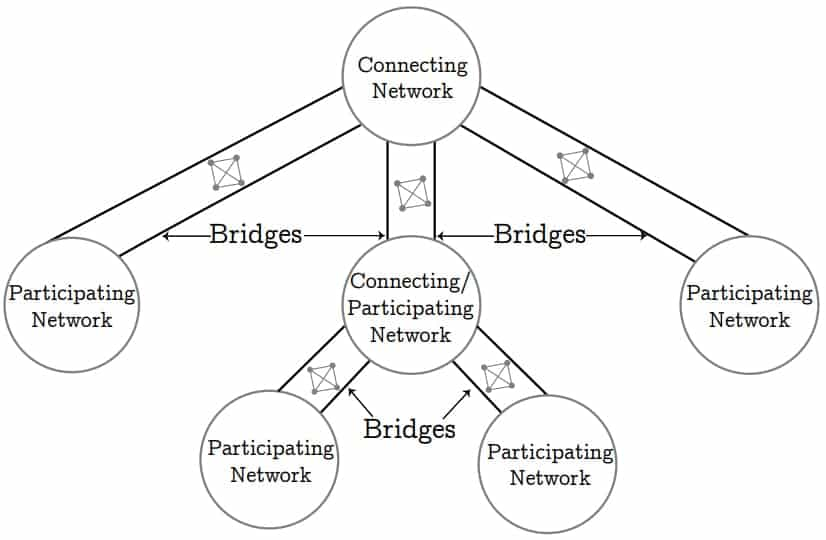
Bridges carry out two primary functions:
- Signing and broadcasting any interchain transaction the moment it has been packaged in a block and the transaction forwarding fee is paid;
- Keeping the connecting network informed of merkle hash updates in regard to the contributing network.
A blockchain can have more than one bridge if multiple groups of verifiers sign up and use dissimilar identifiers. The connecting network sees each bridge as distinct, even though they are all broadcasting and receiving messages towards the same network. This makes it the users responsibility to identify which bridge they want to use by providing a target network ID.
This is meant to be beneficial for the network and users since it will create competition between the various bridging networks in terms of stability and pricing. Each network will develop a reputation and market demands will ensure optimal pricing for bridge users.
The Aion Virtual Machine
The Aion Virtual Machine is unique as it is based on a lightweight Java Virtual Machine implementation that has been crafted specifically for Aion to execute chain logic in its distributed network.
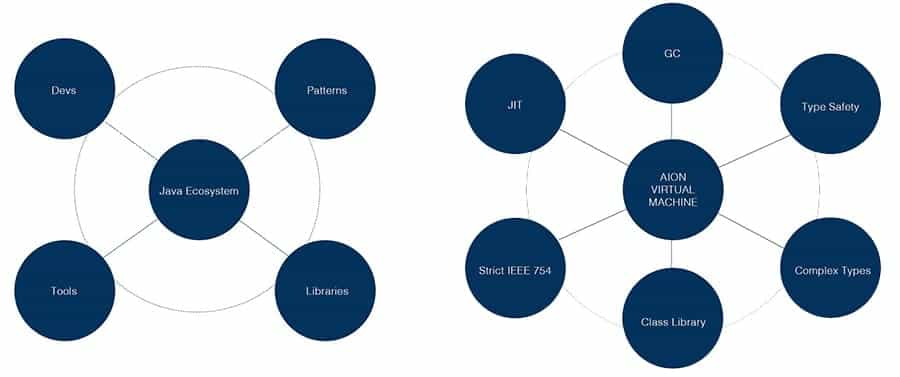
Java was chosen to provide performance and robustness to the network. Based on the Ethereum Virtual Machine it is 128-bit and is the next step towards a more robust ecosystem of interchain dApps.
The Aion API
Aion supports both Java and web3 programming interfaces for developers and its Java API implements JDK8, but also uses elements of JDK9 and JDK10. The API gives developers an interface for Java based dApps, while the web3 module allows for smart contract execution.
The Aion Team
The founders of Aion consist of former Deloitte blockchain team employees. The CEO is Matt Spoke, and the Chief Technical Officer is Jinius Tu (or Jin). The full team spans the globe, with 49 employees, most of whom are located in Toronto. Additional employees are located in the U.K., Shanghai and Barbados.
The founders saw the need for a public blockchain with the capability to connect various other blockchains while they were working together at Deloitte.
Initially, the company was formed as Nuco Global, but it switched to Aion Foundation in July 2018. The switch took the company from a public corporation to a non-profit foundation.
The entire team brings strong development and marketing skills to the Aion project, which increases the likelihood of long-term success.
The Aion Community
Because Aion is a permissionless blockchain it’s possible for anyone to run an Aion node, and it is also possible for anyone to mine Aion. Currently, there are over 2,000 miners helping to secure the Aion network, and as the network grows the number of miners is also expected to grow.
Community involvement and contributions are encouraged by the Aion development team, and this makes the Aion Telegram and Discord channels quite active. The Telegram channel is particularly active with over 32,000 members, while the Discord channel has nearly 5,000 members.
In addition to sharing ideas on Telegram and Discord, developers are also able to submit Aion Improvement Proposals. Developers are further incentivized through the use of bounties and grants.
Aion social networks are also quite popular. The Facebook page has over 85,000 followers, and such a large number of followers on Facebook is unusual for blockchain projects. They also have over 67,500 Twitter followers and a blog that’s updated fairly regularly.
And on Reddit, which tends to be the most popular social media hangout for blockchain enthusiasts, Aion has over 72,000 followers and an active subreddit.
AION Token Performance
Aion was fortunate in holding its ICO during the heady days of late 2017, when the cryptocurrency markets were rallying so hard invetors were willing to pay for any token that came along. Not that this makes Aion a bad token, but it certainly helped the team in easily reaching their $20 million hardcap.
In fact, when you also factor in the private sale of 10% of the total tokens that occurred in October 2017 the team was able to bring in a reported total of $23 million in BTC, ETH and fiat currency.
The sales model was an interesting one, benefiting those that bought early in the ICO. During the first 10 minutes, tokens were priced at $0.75, with the price increasing by $0.05 every 10 minutes until it reached $1.00.
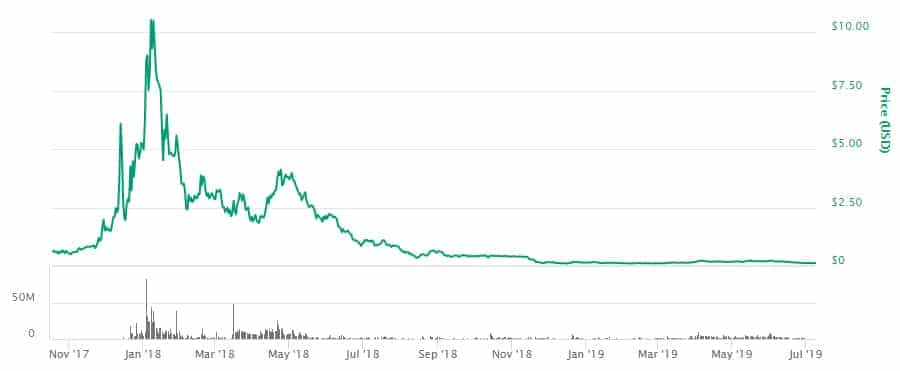
With the cryptocurrency markets in full on rally mode in December 2017, the price of Aion jumped right from the start, and by January 8, 2018, it reached an all-time high of 11.51. Three months later the token was trading for just $1.84.
There was a recovery following the drop, which lasted for a month and took the token back to above $4.00 briefly before it began a slow slide throughout the remainder of 2018 that ended with the token finally hitting an all-time low of $0.104253 on February 6, 2019.
Since then the token has recovered, but not in-line with many other cryptocurrencies as it trades at just $0.128614 on July 8, 2018. That’s far less gains in 2019 than we’ve seen for most of the top cryptocurrencies.
Buying & Storing AION
Those who feel this is bargain pricing for the token can purchase it at a large number of exchanges, with the largest volume seen at Binance. There are also reasonable volumes on LATOKEN with much smaller numbers on the likes of DragonEX and KuCoin.
In terms of liquidity, there appears to be reasonable turnover levels on the top exchanges. For example, you have about $871k in 24 hour volume on the likes of Binance (BTC pairing). This means that most orders are unlikely to encounter slippage.

Once you have your AION tokens, you will want to move them off of the exchanges. We are all well aware of the risks that come from centralised exchange hacks.
There are currently a number of options for storing your Aion tokens. The Aion Desktop wallet (Windows, Linux Mac OS) perhaps the most popular. Mobile users might want to check out the Trust Wallet which has support for Aion tokens, and for the security conscious the Ledger Nano S also has support for Aion tokens.
One final option is the Coinomi wallet which is a third-party multicurrency wallet. This supports both desktop and mobile devices across a number of different operating systems.
Aion Development
Sometimes it can be tough to determine exactly how much work is being done on a project. However, one of the best indications is to go directly to their public code repositories.
Hence, I decided to move on over to the Aion GitHub to get a better sense of exactly how much code is being pushed by their developers. In the below we have the code commits for their three pinned repos.
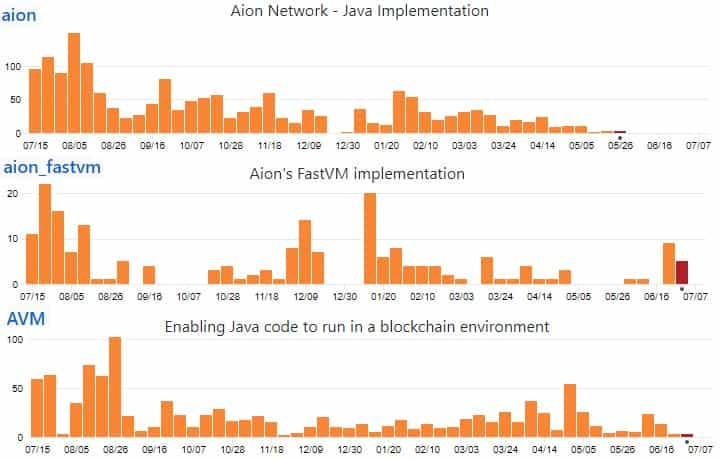
As you can see, there is a great deal of work that has been completed. It is also worth pointing out that Aion has a further 29 other repositories that have varying degrees of coding activity.
This is much more than we have seen on other projects at similar levels of development. In fact, Aion ranks at number 23 in terms of coding commits on CoinCodeCap. It is sitting just between Gnosis and Loopring.
Indeed, all of this coding activity will make sense when one takes a look at their roadmap.
Aion Roadmap
Over the past year, Aion was able to meet all of the milestones that they had laid out for their first "Kilimanjaro" phase of their Roadmap.
These include some really important releases including their Fast Virtual Machine and EVM source code implementation. They have also built the token bridge which will migrate the ERC20 tokens to AION coins.
The team is currently busy on their second or "Denali" phase. Finally, to reach the summit of blockchain interoperability, they will move onto their "Everest" phase.
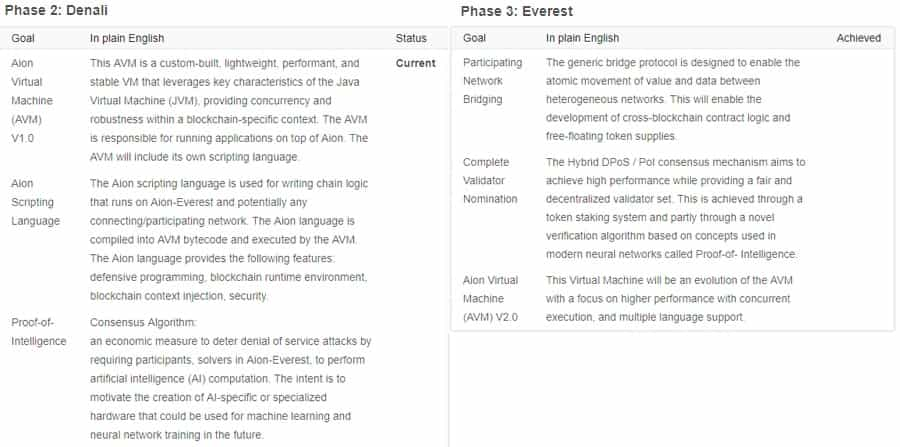
It will be interesting to see whether the developers will be able to meet their future milestones to the same degree that they have for their past ones.
If you want to keep up to date with the project then you can follow all of their development announcements on their blog. I found these to be quite informative.
Conclusion
The evolution of the blockchain ecosystem has been occurring at a breakneck pace, but one thing that’s still missing is an effective way to create interoperability between blockchains.
Aion thinks it has the solution to this and wants to make cross-blockchain transactions and communication a reality. The hub-and-spoke architecture and bridge infrastructure proposed by Aion is a unique solution that was unprecedented when it was first introduced.
That makes Aion the catalyst which began a whole new direction for blockchain technology, but it doesn’t mean that they will be the leader or the accepted solution that eventually enables blockchain interoperability.
They are up against a number of well funded and talented competitors who are also seeking a solution to interoperability. Current competitors include Wanchain, Komodo, Ark Ecosystem, Cosmos, POA Network and Polkadot. All of them feel they have the solution to interoperability between blockchains.
With so many projects working on interoperability, it’s pretty certain a solution will eventually emerge, but it might not be from any of the existing projects, or it could come from a collaboration of several.
Whether Aion will be a part of the eventual solution remains up-in-the-air, but if the token price so far in 2019 is an indication it seems the market is not viewing the chance of success as favorable.
Disclaimer: These are the writer’s opinions and should not be considered investment advice. Readers should do their own research.
